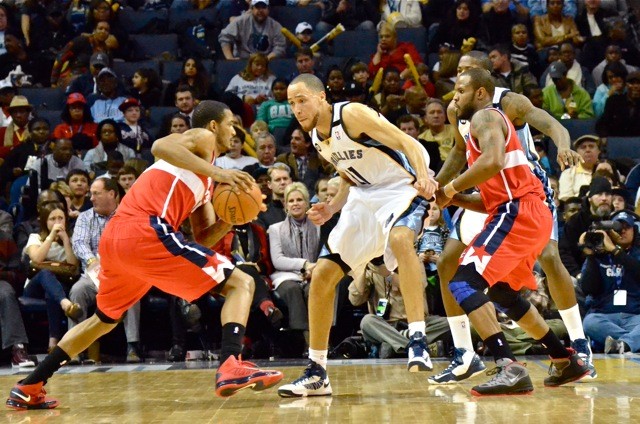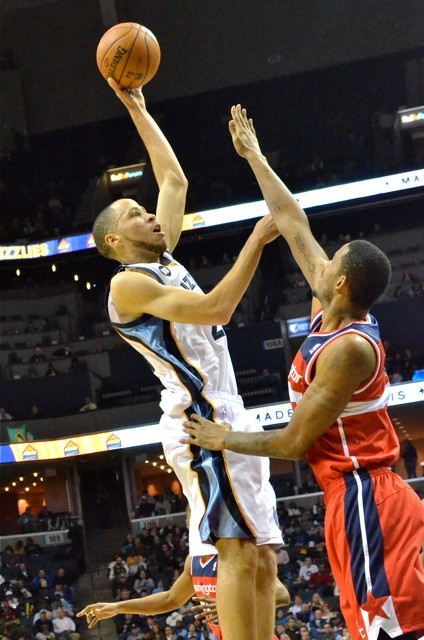A new era of Memphis Grizzlies basketball dawned last weekend when the Grizzlies played their first home game without Rudy Gay. While there are many angles to the trade that sent Gay out of Memphis, the simple lineup swap of Gay for veteran Tayshaun Prince will have the most immediate impact. And the contrast, at least stylistically, could be dramatic.
Gay, at 26, is one of the NBA’s great athletes, but his often erratic play has, so far, prevented him from reaching the all-star level for which he’s long seemed destined. Prince, who will turn 33 later this month, is a 10-year vet winding down a fairly illustrious career for lifetime role player.
Physically, Prince is both longer and lighter, a slender 6’9″ with one of the NBA’s most eye-popping wingspans. Where Gay’s game is predicated on leveraging his athletic advantages, Prince’s game is all about the combination of length and savvy.
Prince’s wingspan allows him to play well off shooters to deny drives and yet still contest jump shots. It allows him to handle the ball on the block while keeping it away from the prying hands of post defenders. It allows him to shoot over opponents, especially in the paint, even without Gay’s ability to jump over them.
The key is going to come on the offensive end, where the Grizzlies will be exchanging usage for efficiency. This season, Gay’s “used” — via shot attempts, turnovers, or assists — more than a quarter of the Grizzlies’ possessions when he’s been on the floor but has done so with the worst shooting of his career and a typically rocky turnover rate. Prince, by contrast, typically uses fewer possessions but does so with better outcomes. But this trade-off will be tricky for the Grizzlies, who will no longer be able to rely on Gay’s shot-creation as a bailout option.
Prince is a versatile scorer who does most of his work from mid-range (where he consistently shoots better than Gay), but he can also work from the post and is a solid but not prolific three-point shooter — something that’s not likely to change, despite the team’s dire need for more outside shooting. Prince won’t score as much as Gay did, but the team can reasonably hope he’ll score more efficiently while helping facilitate better shots for others.
And that’s the biggest advantage Prince will have over Gay. Prince is both a better passer and less turnover-prone. In his career, including this season, Prince has almost always had more than twice as many assists as turnovers. Gay’s usually struggled to break even. Where the offense would often stagnate with the ball in Gay’s hands, Prince can be expected to make quicker, more sound decisions. Prince has spent his career using his versatility to be a positive-outcome player as a third or fourth option, and you could see this materialize instantly in his weekend debut.
On the floor with Zach Randolph, who likes to operate on the block, Prince worked from the wing, playing off Randolph with deft post-entry passes and reliable mid-range shooting. On the floor with Darrell Arthur, who’s best from the top of the key, Prince himself went into the post, drew a double-team, and kicked it out to Arthur for an open shot.
Prince won’t resemble a “star” like Gay did. But he’ll blend, facilitate, and foster better ball movement. It’s probably not an accident that, in Prince’s pick-up-game-like debut, the Grizzlies had five players notch three or more assists.
In truth, Gay’s production has not correlated strongly with team success this season. That’s been more dependent on the play of the point guards and the post players and the team’s three-point shooting overall. And that was likely to be the case going forward, trade or not. If Prince’s divergent style can enable others to perform better, that will mean much more than his own stat line.
For more on the Grizzlies, see “Beyond the Arc,” Chris Herrington’s Grizzlies blog, at memphisflyer.com/blogs/beyondthearc.


